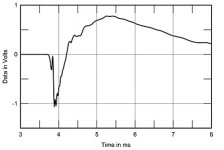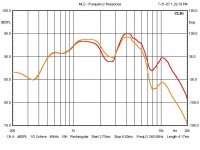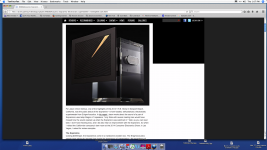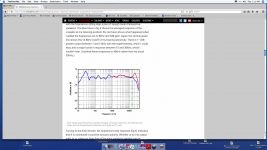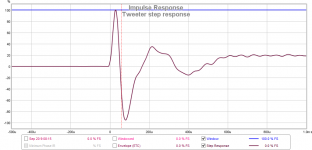It will be interesting to see the time domain harmonic analysis from Demian.This is all reluctance force. At 200/250Hz the cone mass controls excursion so the suspension doesn't play much of a role unless you have an additional frequency near Fs to stress it. I have nonlinear suspension modeling but it mainly affects the 50Hz difference tone IIRC.
I'm curious if asymmetry in the sidebands or similar esoterica could be used to determine asymmetric reluctance from the magnetized steel?
You can output in time domain, yes? From your lissajous it looks like the first three or four cycles should be cut out for a time domain analysis.
It will be most instructive to see if your modelling is able to model accurately in the time domain, as we have to make sure that we do not accept results simply because it produced spectra consistent with expectation.
In the time domain, it would be nice to track the distortion components vs cone position.
edit:Ah, forgot to ask. What is your equation for the reluctance force?
jn
ps...are you Tony, or Doug? ( or, are you even old enough to recall a tv show from 1966? )
Last edited:
I have serious problems with Blues. Specifically, the lack of enough cone surface area times excursion. That, and objects of worth that are not glued to the shelves.😀🙂
Just a little gift for you:
YouTube
This is what both a genius guitarist and a great blues man can give in matter of fast and "feel".
Clapton used to say: When I arrived in the Nashville studio, I was invited to play with some old black guitarists in there. I was highly impressed. Blues is a man's music and I was just a child."
I'm pretty much an onlooker here.. others are doing fantastic stuff, I'm just watchin.Keep up your good work after this intermission.
jn
PMA, this is a good point for discussion: What about 'time response' and how much can we hear, and accept as high fidelity. Here are 2 time responses coupled with frequency response measurements for the speakers I am now listening to in my living room. One costs retail, 40 times the other. Yet I generally prefer to listen to the cheap one on REGULAR PROGRAM MATERIAL transmitted over Comcast, that is TV, FM, and music channels. My recent favorite is actually a 24hr blues channel that I listen to at about 70spl. It love it! Now, what is wrong with the $28,000 speakers? Please note the time response, and the abrupt tweeter cut-off. Yes, I can hear them.
Attachments
Here is an 'improved' speaker at twice the price, but better sounding than the standard Sasha:
It seems that, maybe, Sasha's tweeter to midrange transition is not optimal, not perfectly time-aligned. Also look at dips and ridges above 5kHz.
Last edited:
This would be Watt/Puppy, or Alexia. Better time alignment. You complain about all-pass response. This is an interesting point, however not sure (no evidence) about audibility, when, under what conditions exactly.
Happy holidays 😉
I think more real world results would be appreciated, we are mostly on purely theoretical side and I am not sure if we address the main issues, or side effects.
JN, it's time to make measurements and decisions. Speaker is an electro-acoustical transducer, it is not E/M only. Please do not concentrate on partial feature only. Maxwell's are a useful start, but do not help much to solve particular issues.
It's hard to believe this was posted just yesterday. Man, this thread moves fast.
The heart of any e-dynamic speaker is the magnetics. If they produce intermodulation at the magnetics level, I believe it important to address that first. Until it is fully understood, all we have is trial and error.
Worrying about the suspension non linearities is quite important, but the magnetics are the fundamentals.
If keantoken's simulation is correct, it has the capability of exactly duplicating your real world measurements. If confirmed in the time domain, it provides a smoking gun for intermodulation that we can play with.
It will also be nice if you use the same driver same stimulus, but current controlled.
I can't imagine what the output spectra would look like with 6, 7, 10 different frequencies driving the speaker... like, music.. wow.
jn
I would appreciate if JA posted step response measurement at higher Fs and also in more detailed time resolution. I would also appreciate if he not only posted a step response, but also an impulse response.
ENIGMAcoustics Sopranino electrostatic supertweeter Measurements | Stereophile.com
ENIGMAcoustics Sopranino electrostatic supertweeter Measurements | Stereophile.com
Oh well, JA can't do everything. I am personally too lazy to make the detailed measurements myself. Yet there is enough to discuss if you wanted serious comparison between the different speaker designs.
Oh well, JA can't do everything. I am personally too lazy to make the detailed measurements myself. Yet there is enough to discuss if you wanted serious comparison between the different speaker designs.
I mean a resolution (measurement) at least like this, when speaking about tweeters.
Attachments
Some points regarding speaker drivers and loudspeakers.
I understand that the field produced by the driven VC causes modulation of the magnet structure and consequent modulation of the field intensity of the VC gap.......could an auxiliary coil be mounted to the magnet structure to counter this and keep VC gap field more constant or actively compensated ?.
I have observed modulated magnetic 'beam' extending forward from and inline with the central pole piece, detectable four metres away with suitable pickup coil......would a measurement/sensing coil mounted directly in front of the cone be useful ?.
I also find that magnet structures are noisy.....my 'goop' placed at the center of the back plate (which is also incorporates the central pole piece) very audibly alters and in this case improves the clarity and 'tone' of typical speaker drivers......driver THD and IMD distortions are not the last word on perceived quality and 'voicing' of loudspeakers.
Dan.
I understand that the field produced by the driven VC causes modulation of the magnet structure and consequent modulation of the field intensity of the VC gap.......could an auxiliary coil be mounted to the magnet structure to counter this and keep VC gap field more constant or actively compensated ?.
I have observed modulated magnetic 'beam' extending forward from and inline with the central pole piece, detectable four metres away with suitable pickup coil......would a measurement/sensing coil mounted directly in front of the cone be useful ?.
I also find that magnet structures are noisy.....my 'goop' placed at the center of the back plate (which is also incorporates the central pole piece) very audibly alters and in this case improves the clarity and 'tone' of typical speaker drivers......driver THD and IMD distortions are not the last word on perceived quality and 'voicing' of loudspeakers.
Dan.
Is there any evidence of this at all, even the tiniest little bit? A change of "tone" should be easy to prove, unless, of course you don't mean tone, which is probably why you used quotation marks?I also find that magnet structures are noisy.....my 'goop' placed at the center of the back plate (which is also incorporates the central pole piece) very audibly alters and in this case improves the clarity and 'tone' of typical speaker drivers......driver THD and IMD distortions are not the last word on perceived quality and 'voicing' of loudspeakers.
Just got through firing up a coal forge I made form an oval roaster with a mixture of ash and cat litter. I made a crooked butterknife that's twice as long as it should be and is prone to rust. But it might be hardenable?
It's SPICE, time domain is the default. I was just curious what an XY plot of the velocity eddies would look like. For me, I don't mind ignoring the first few cycles since I swim in SPICE, but I would do it for an article or a particularly insistent friend.
It turns out the sidebands right next to 200/250Hz require an extra distortion mechanism, maybe nonlinear air resistance. Also it is hard to get the harmonics to decay as fast as they do in PMA's plot.
Looking at the work from the distortion prediction papers, none of it is stuff SPICE can't do aside from realtime and self-adjustment stuff. The time domain simulation is practically what SPICE was designed for. But it won't transfer directly to a realtime system.
I used a separate equation in my last model, what a terrible idea. The flux loop can be modeled as a circuit, reluctance force comes naturally from that. Why would I want to play with all these separate equations when I can model the actual physical thing and derive the behavior from how it actually works? What are Klippel and all these guys thinking???
Let me get my calculator... It turns out I'm 25. And no, I don't get any of the references you guys throw out.
I think I floated that idea on this thread a year or so ago. You need to make room for the coil, but unless it's right next to the voicecoil like in the patent Richard brought up, it won't fix eddy current issues (even that wouldn't fix them all). But it looks like eddy currents aren't the majority of distortion for most mid or woofer drivers. If you have a lathe and can remove the pole piece without damage I don't see why it can't be done.
You would probably get too much signal from the portion of the coil in air outside the driver. But, that's not to say it couldn't be useful somehow.
You can output in time domain, yes? From your lissajous it looks like the first three or four cycles should be cut out for a time domain analysis.
It's SPICE, time domain is the default. I was just curious what an XY plot of the velocity eddies would look like. For me, I don't mind ignoring the first few cycles since I swim in SPICE, but I would do it for an article or a particularly insistent friend.
It will be most instructive to see if your modelling is able to model accurately in the time domain, as we have to make sure that we do not accept results simply because it produced spectra consistent with expectation.
It turns out the sidebands right next to 200/250Hz require an extra distortion mechanism, maybe nonlinear air resistance. Also it is hard to get the harmonics to decay as fast as they do in PMA's plot.
Looking at the work from the distortion prediction papers, none of it is stuff SPICE can't do aside from realtime and self-adjustment stuff. The time domain simulation is practically what SPICE was designed for. But it won't transfer directly to a realtime system.
edit:Ah, forgot to ask. What is your equation for the reluctance force
I used a separate equation in my last model, what a terrible idea. The flux loop can be modeled as a circuit, reluctance force comes naturally from that. Why would I want to play with all these separate equations when I can model the actual physical thing and derive the behavior from how it actually works? What are Klippel and all these guys thinking???
ps...are you Tony, or Doug? ( or, are you even old enough to recall a tv show from 1966? )
Let me get my calculator... It turns out I'm 25. And no, I don't get any of the references you guys throw out.
I understand that the field produced by the driven VC causes modulation of the magnet structure and consequent modulation of the field intensity of the VC gap.......could an auxiliary coil be mounted to the magnet structure to counter this and keep VC gap field more constant or actively compensated ?.
I think I floated that idea on this thread a year or so ago. You need to make room for the coil, but unless it's right next to the voicecoil like in the patent Richard brought up, it won't fix eddy current issues (even that wouldn't fix them all). But it looks like eddy currents aren't the majority of distortion for most mid or woofer drivers. If you have a lathe and can remove the pole piece without damage I don't see why it can't be done.
I have observed modulated magnetic 'beam' extending forward from and inline with the central pole piece, detectable four metres away with suitable pickup coil......would a measurement/sensing coil mounted directly in front of the cone be useful ?.
You would probably get too much signal from the portion of the coil in air outside the driver. But, that's not to say it couldn't be useful somehow.
Last edited:
One day I will get around to measuring/documenting the effects I speak of here and previously.Is there any evidence of this at all, even the tiniest little bit? A change of "tone" should be easy to prove, unless, of course you don't mean tone, which is probably why you used quotation marks?
In the meantime I have observations rigorously subjectively proven and subjective results that range from 'dead clean' through to deliberately 'coloured' or 'toned' and deliberately 'good' or 'bad', predictably and at will.
Ok, so all of you here can't get your 'heads around' this concept, I don't expect you to do so without personal experience, indeed it has taken me a very long time to do so.
The bottom line is that noise excites and drives further noise production which drives further noise production system stage by system stage resulting in the sorry messes that so many systems are.
By suitably applied filtering this noise production can be effectively quenched and essentially subjectively eliminated, and known/controlled noise can then be added back in to cause 'voicing' or 'naturalness' at will.
Before any of you object to my above statements be sure to understand that these noise processes are what is going on already and right under our noses.
Swapping out for example the system AC power cable will alter downstream system noise production amplitude and spectral/dynamic nature.
Ditto swapping out just one system semiconductor or passive component will both filter noise and introduce characteristic noise with consequential change in final system transduced output.
Noise production is also driven/excited by 'simple' harmonic and intermodulation distortions so keeping these distortions low does provide benefit, but is ultimatly overtaken by other noise driver mechanisms.
So carry on with the speaker driver investigation. ....getting the acoustic output THD/IMD distortion lower will be of benefit but will come at the expense of generating new noises that cannot be eliminated by conventional electronic means.
Dan.
Figured.Let me get my calculator... It turns out I'm 25. And no, I don't get any of the references you guys throw out.
Back in '66, a show called "time tunnel" ran. Doug and Tony were the guys stuck in time.
On the set, there was this large CRT (sorry, cathode ray tube for you younguns...😀) that displayed lissajous. Calm and easy patterns normally, frenetic when stuff was happening, like the Titanic, Halley's Comet, Krakatoa, you know, the normal stuff an out of control time machine sends you to..
Your x/y plots reminded me.
Sigh, I hate you young guys, you missed all the really campy sci fi.
Jn
- Status
- Not open for further replies.
- Home
- Member Areas
- The Lounge
- John Curl's Blowtorch preamplifier part III
